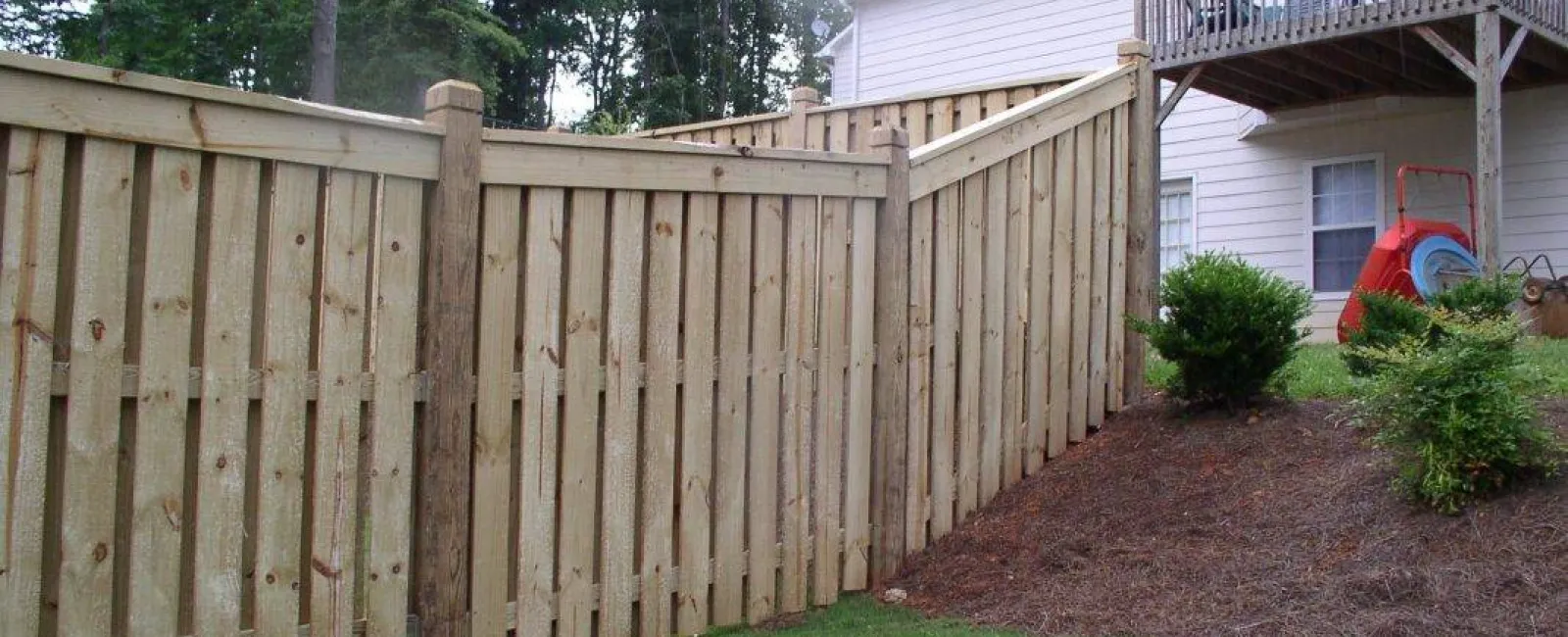Thinking about installing a wooden fence? First Fence of Georgia’s pros and cons checklist can help you get the facts you need to know.
People have been building wooden fences for hundreds of years. Split-rail was the first wooden fence type to gain popularity in the U.S.
Made from the once abundant American chestnut, these stacked timber fences could zigzag across uneven terrain, marking pioneer boundaries.
We’ve come a long way since then, but wooden fences are still a big part of the American landscape. From classic white picket fences to ranch rail to stockade privacy fencing, you can find wood fences in almost every neighborhood across the country.
We Love About the Wooden Fence
There are many reasons to choose wood for your fencing. Wood is an abundant resource, so wooden fence installation tends to be more cost effective than some other materials.
Wood is also eco-friendly. It’s a renewable resource, especially when you use fast-growing varieties like pine. It’s also biodegradable and organic.
Additionally, wood is very versatile fence material. It works well for many different fence design options. It can also be painted or stained to complement most aesthetics.
Wood is an effective sound-absorber. It’s a natural insulator that can help reduce noise pollution.
Finally, wood holds timeless curb appeal. From rail fences to picket fences, wood offers a sense of warmth and coziness that never goes out of style.
However, there are some disadvantages to a wooden fence that you should consider before installation.
Things to Consider
Wood is an organic material, which is a big part of its appeal. Because it’s organic, it’s vulnerable to decomposition over time.
Decomposition can take the form of dry rot, warping, splitting, fading, and termite or other insect damage. Regular maintenance can help forestall these problems, but it may not prevent them altogether.
That maintenance involves things like pressure washing, staining, painting, and repairing damaged boards. This can be a deterrent for people who want to “build it and forget it.” Additionally, a pressure-treated wooden fence’s average lifespan is around 10-15 years. Left without regular maintenance, they can deteriorate much faster.
Why Do Wooden Fence Boards Warp?
To state the obvious, a wooden fence is made from trees. Trees are made up of fibers that soak in water from their natural environment. They store the water for later use so that they can survive times of drought.
When trees are cut down and milled into lumber, they retain water. Even if that water evaporates, the wood fibers will soak in water over time.
When wood soaks in water, it expands. The fibers grow both radially (thickness) and tangentially (width.) However, the rate of expansion isn’t consistent.
Wood fibers expand almost twice as much tangentially as they do radially. That means the width of the board can grow faster than the width.
And when heat once more causes the water to evaporate, the boards shrink. This cycle of uneven expansion and shrinkage eventually leads to warping, cracking, and splitting.
How Can I Prevent My Wooden Fence Boards from Warping?
In short? You can’t. Not indefinitely, anyway. However, there are several steps you can take to prolong the life of your wood fence
Use Cedar, Redwood, or Fir
These types of wood naturally absorb less water. That means they’re not as prone to warping.
In fact, redwood can absorb water through their leaves. This ability to “drink fog” means that they don’t need to absorb and store as much water as other varieties.
Cedar is also one of the thickest types of wood, which helps keep wood picket fencing from warping.
However, these types of wood fences are typically more expensive than other popular softwoods like pine.
Use Pressure Treated Wood
Pine is one of the most abundant wood sources, making it less costly. It’s also a softwood and absorbs a lot of moisture.
To combat this, a process called pressure treating was developed in the 1940s.
Pressure treating uses pressure to push chemicals deep into wood fibers. The chemicals help the wood resist rot, decay, and termite damage. It also absorbs less moisture, meaning less warpage.
Apply a Sealant
To help keep your wooden fence in good shape for as long as possible, apply a sealant. The sealant can be clear or colored to complement different wood fence styles.
Not only will a sealant help keep water out/in, but it will also block UV. Like moisture, the sun’s rays contribute to the expansion and contraction cycle that causes so much damage.
This process should be repeated every 2-3 years for the best results.
Choose the Right Fence for Your Project
If you’re wondering if a wooden fence is right for you, First Fence of Georgia can help. Our knowledgeable staff can answer your fence wood questions, explain the process, and assist you with all your fencing needs.
Contact First Fence of Georgia for All Your Fencing Needs
If you have additional questions about building a fence on uneven ground, our knowledgeable professionals can help. We offer custom built fence designs to suit your needs. You can reach us at (770) 422-9996


